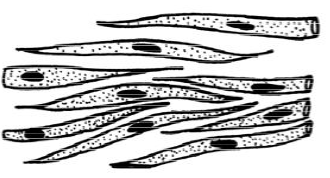
Why are smooth muscles called involuntary in nature?
Answer
494.7k+ views
Hint: Involuntary muscles are those that cannot be controlled by will or consciousness and are frequently associated with organs that contract and relax slowly and regularly. Because there are no striations when viewed under a microscope, involuntary muscles are also known as smooth muscles or non-striated muscles.
Complete answer:
Smooth muscles can be found in the oesophagus, stomach, intestine, blood vessels, iris of the eye, and dermis of the skin. They are involuntary because they cannot be directly controlled. The autonomic nervous system regulates the action of these muscles.
Smooth muscle is a type of muscle tissue that is used to apply pressure to vessels and organs by various systems. Smooth muscle is made up of smooth muscle cells arranged in sheets or strands. These cells have actin and myosin fibres that run through the cell and are supported by a protein framework.
Smooth muscle contracts in response to certain stimuli as ATP is released for use by myosin. The amount of ATP released is proportional to the intensity of the stimuli, allowing the smooth muscle to contract in a graded manner as opposed to the skeletal muscle's "on-or-off" contraction.
Smooth muscle, like all muscle tissue, can contract. The image above depicts how actin and myosin fibres shorten, causing the cell to shrink. However, there are some significant differences between smooth muscle and other types of muscle in terms of how they contract.
A signal from the somatic nervous system travels to the muscle and stimulates organelles in the muscle cell to release calcium. Calcium causes a protein to detach from actin, and myosin binds to the opening on actin very quickly. Because ATP is always available, myosin uses it to rapidly contract the cell. While smooth muscle does not contract or release as quickly as skeletal or cardiac muscle, it is far more useful in terms of providing consistent, elastic tension.

Thus, the smooth muscles are called involuntary in nature.
Note: Smooth muscle, because of its ability to contract and hold, is used for a variety of functions throughout the body. Smooth muscle is also responsible for contracting the irises, raising the small hairs on your arm, contracting the many sphincters in your body, and even moving fluids through organs by applying pressure to them, in addition to the functions listed above.
Complete answer:
Smooth muscles can be found in the oesophagus, stomach, intestine, blood vessels, iris of the eye, and dermis of the skin. They are involuntary because they cannot be directly controlled. The autonomic nervous system regulates the action of these muscles.
Smooth muscle is a type of muscle tissue that is used to apply pressure to vessels and organs by various systems. Smooth muscle is made up of smooth muscle cells arranged in sheets or strands. These cells have actin and myosin fibres that run through the cell and are supported by a protein framework.
Smooth muscle contracts in response to certain stimuli as ATP is released for use by myosin. The amount of ATP released is proportional to the intensity of the stimuli, allowing the smooth muscle to contract in a graded manner as opposed to the skeletal muscle's "on-or-off" contraction.
Smooth muscle, like all muscle tissue, can contract. The image above depicts how actin and myosin fibres shorten, causing the cell to shrink. However, there are some significant differences between smooth muscle and other types of muscle in terms of how they contract.
A signal from the somatic nervous system travels to the muscle and stimulates organelles in the muscle cell to release calcium. Calcium causes a protein to detach from actin, and myosin binds to the opening on actin very quickly. Because ATP is always available, myosin uses it to rapidly contract the cell. While smooth muscle does not contract or release as quickly as skeletal or cardiac muscle, it is far more useful in terms of providing consistent, elastic tension.

Thus, the smooth muscles are called involuntary in nature.
Note: Smooth muscle, because of its ability to contract and hold, is used for a variety of functions throughout the body. Smooth muscle is also responsible for contracting the irises, raising the small hairs on your arm, contracting the many sphincters in your body, and even moving fluids through organs by applying pressure to them, in addition to the functions listed above.
Recently Updated Pages
Master Class 12 Business Studies: Engaging Questions & Answers for Success

Master Class 12 Economics: Engaging Questions & Answers for Success

Master Class 12 English: Engaging Questions & Answers for Success

Master Class 12 Maths: Engaging Questions & Answers for Success

Master Class 12 Social Science: Engaging Questions & Answers for Success

Master Class 12 Chemistry: Engaging Questions & Answers for Success

Trending doubts
Who was the first woman to receive Bharat Ratna?

Write a letter to the principal requesting him to grant class 10 english CBSE

Why is there a time difference of about 5 hours between class 10 social science CBSE

What is the median of the first 10 natural numbers class 10 maths CBSE

The Equation xxx + 2 is Satisfied when x is Equal to Class 10 Maths

Discuss the main reasons for poverty in India




